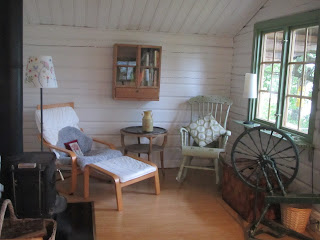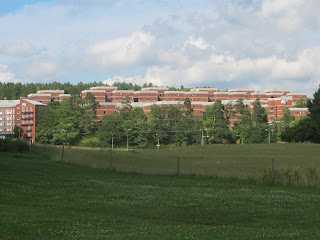This week I spent a few days with a Wellesley alumna and her family both at their Stockholm house and their summer home outside the city. When I arrived in Sweden I contacted the Nordic Wellesley Alumnae Association. I figured if any alumnae lived in the area, it would be nice to meet them. Julie Lindahl, class of '88, contacted me and this week I spent some time at the Lindahl's summer house on their island in Lake Mälaren. I had an absolutely fantastic time with her, her husband, and her two children. And her dog. I loved hanging out with Ellie the dog.
 |
| The Lindahl's dog, Ellie |
For those of you who don't know, I have a dog named Jazzy back home, and I have often said (much to my mother's joking chagrin) that Jazzy is who I'll miss the most when I'm gone. I mean, I love my family and friends, but we can always keep in touch with email or Skype, and some people are going to visit me throughout the year. Not hanging out with Jazzy for a whole twelve months, however, will most likely be the hardest. So spending a few days with someone else's dog was great!
I met up with Julie at her Stockholm home in Drottningholm on Monday. She lives right across the street from Drottningholm Palace, which is a beautiful UNESCO World Heritage Site.
 |
| Drottningholm Palace |
It must be great to have all the palace gardens and the park so close. In fact, her house is one of the oldest in the area, and the neighborhood used to be filled with people who worked in the palace. After meeting up, we ran some errands in the city, and I learned a lot about Julie. She's lived all over the world and is a really fascinating person. And of course, I loved reminiscing about Wellesley together. She's an author, and I'm really excited to read her books, especially Rose in the Sand, since it is a memoir about when she lived year-round on the island I visited.
Julie, her daughter and I drove out to their island Malmhuvud, which is only an hour outside of Stockholm. Her son and husband were already there. Their island has a footbridge, so we could park in the forest on the mainland (which is actually a big island, of course) and walk to their home. The area used to be filled with the sand-mining business until around the 1920's. This island was so cool. Their family owns most of it, and it was such a lovely place.
 |
| Their house |
 |
| Looking out at the lake |
 |
| Their boat dock |
 |
| Looking down at the water from by the house |
I got my own little guest house, and I loved being out out in nature and right by the water.
 |
| My guesthouse on Malmhuvud |
 |
| View from guesthouse |
It reminded me a lot of Island 70 (although on a larger scale) so of course I thought it was awesome. I love to be near the water. For those of you who don't know, Island 70 is my grandparents' place up on the St. Lawrence River in Canada.
The first night we had a great dinner with lots of Swedish specialties. Because I am cooking for myself here rather than going out to restaurants, I haven't tasted a lot of the local food. Monday's dinner included local cuisine like smoked salmon, new potatoes, and for dessert, gooseberry soup. I must say, gooseberry soup is so delicious.
While I would have loved to go out to their island regardless, Julie had told me earlier that there is a wreck of a sand mine barge in their harbor that was purposefully sunk around the 1920's when the mining ended. In fact, Lake Mälaren is filled with wrecks of all kinds. I took my snorkeling gear along, and on Tuesday morning I swam around looking for the wreck. However, the visibility was really bad, probably about five feet. Honestly, it was a little unnerving to be swimming around looking for a wreck when I couldn't see past my extended arm. I think I found it, because my fin hit something and there was a smudge of rust on it afterwards. But I really couldn't see much, even with my dive light.
 |
| I think the wreck was below and to the right of the floating dock |
 |
| The wreck was somewhere in this harbor! |
I had fun snorkeling around anyway. And the really bad visibility, paired with the fact that the lake is iced over for months of the year, explains why I hadn't heard much about diving in this huge lake. There are lots of wrecks, but they're hard to appreciate when you can't see them. That made me think about how non-divers consider wrecks. For instance, people know there are all these wrecks in this lake, but it's not like they access them easily or know the exact history of each wreck. Most of the wrecks, like the barge in this harbor, probably aren't old enough to be worth preserving and/or raising with government money. So while in warmer, clearer waters they might be considered great dive sites, the lack of visibility kind of renders them inaccessible to most people. However, for non-divers (and non-snorkelers), all wrecks are basically inaccessible, unless they are raised. This made me consider the benefits of raising wrecks, despite the fact that UNESCO's current stance on underwater heritage sites (like shipwrecks and submerged ruins) is to leave them in situ. But of course, raising a barge like this would probably not be worth it. So it is left in a harbor, where people know it's there, but can't really interact with it.
On Tuesday I also went swimming in a man-made lake nearby, and Julie and her daughter gave me a great tour of the island. We walked to the top of the old sand mine and I had a beautiful view of the lake and many islands nearby. Unfortunately, I didn't bring my camera on that walk.
At the tip of the island, there was a building with a bathroom and garbage area. Julie explained that all around the lake the government installed these buildings on various islands. People often sail the lake for weeks at a time, and these buildings give them a chance to shower, use a regular bathroom, and dump their waste and recycling. It really hit me that while all those wrecks show Sweden's long history of boat transportation, the people are still really interested in being out on the water. From sailing for weeks at a time on Lake Mälaren to motor-boating around Stockholm, the Swedes like to be on the water in the summer. And Sweden has all of these initiatives, like putting in bathrooms and waste centers on the islands for sailors or keeping the water in downtown Stockholm clean enough for swimming, which encourage maritime activities. Sweden's connection to the water isn't just historical; Swedes are still quite connected to maritime culture. That's likely why Sweden has created these maritime museums and underwater archaeology projects.
On our tour of the island I also helped pick mushrooms, which we had for dinner. Mushroom-picking was new for me, but Julie said it's really popular in the forests nearby. In the evening we had a sauna, and I learned all about Nordic sauna culture. Julie wrote a book on Scandinavian well-being, so she has researched all about the history and lore connected to saunas. Julie made us vihtas, which are bunches of birch branches bound together. When using the sauna you're supposed to lightly hit yourself with the birch branches, and they have some sort of natural soap quality which helps clean you. They also smell great. I wasn't a huge fan of saunas when I was younger, but they're growing on me, especially when there's a nice brisk lake in which to jump afterwards. It was wonderful to learn the culture behind them and their significance in Scandinavia.
 |
| The lake |
 |
| The Sauna House |
 |
| The lake |
On Wednesday Julie took me to the local bus stop so I could go back to Stockholm. She also showed me their local church, Munsö Church. It is actually really special, as it is one of 13 round Romanesque churches in Sweden. Some of the stones beneath the church, from an older structure, date back to the 9th century, and the center of the church is from the 12th century.
 |
| Round church |
Since I had to go through Drottningholm on my way back home, I decided to stop and spend Wednesday afternoon exploring the palace and the grounds around it. That'll be my next blog post!
Needless to say, I had a fantastic time meeting Julie and her family.
 |
| Me at Malmhuvud |
I really lucked out to be able to go to such a beautiful island for a few days. It was lovely to go swimming a lot, to be out of the city, and to spend some time with such nice people. And while I didn't go there specifically for my project, I certainly learned a lot about the Swedes' appreciation of underwater heritage, or at least maritime heritage, during my stay on Lake Mälaren.
~Kristine



























